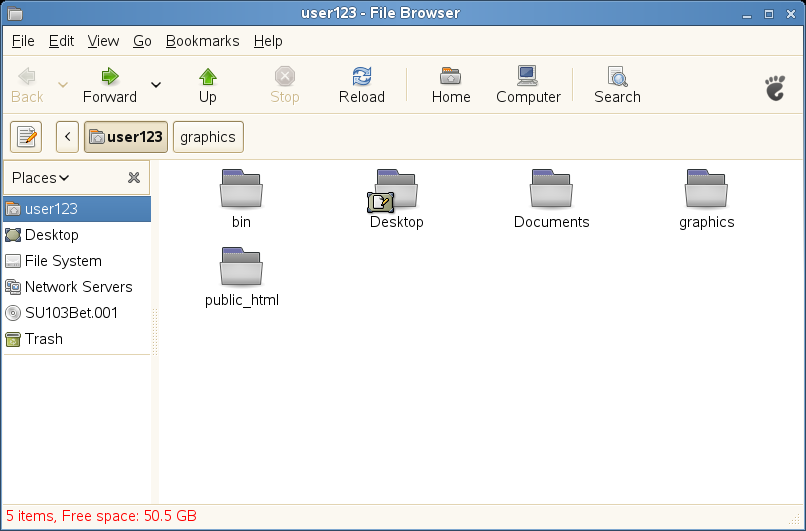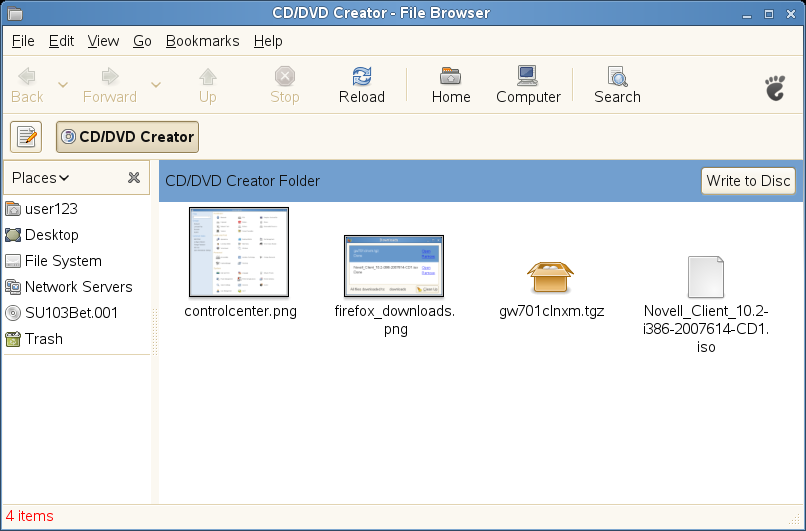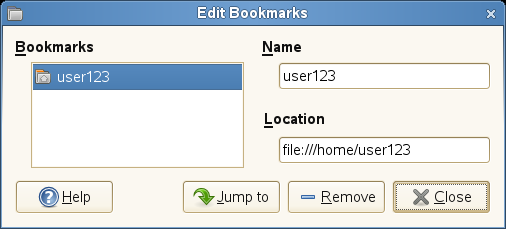1.5 Managing Folders and Files with Nautilus
Use the Nautilus File Manager to create and view folders and documents, run scripts, and create CDs of your data. In addition, the File Manager provides support for Web and file viewing.
You can open the File Manager in the following ways:
-
Click .
-
Double-click your Home directory icon on the desktop.
-
Click or .
Figure 1-6 File Manager

The elements of the Nautilus window include the following:
Menu: Lets you perform most tasks in the file manager. You can also open a pop-up menu from file manager windows by right-clicking in a file manager window. The items in this menu depend on where you right-click. For example, if you right-click a file or folder, you can select items related to the file or folder. If you right-click the background of a view pane, you can select items related to the display of items in the view pane.
Toolbar: Lets you quickly navigate among files and folders, and provides access to files and folders.The toolbar contains Back, Forward, Up, Stop, Reload, Home, Computer, and Search buttons.
Location Bar: Lets you locate files, folders, and URI sites.
Side Pane: Lets you navigate or display information about the selected file or folder. Use the drop-down list to customize what is shown in the pane. The list includes ways to view information about files, perform actions on files, add emblems to files, view a history of recently visited sites, and display your files in the Tree system. To close the side pane, click the X at the top right of the side pane. To display the side pane, click .
View Pane: Displays folders and files. Use the options on the menu to increase or decrease the size of content in the view pane, and to display items as a list or as icons.
Status Bar: Displays the number of items in a folder and gives the available free space. When a file is selected, the status bar displays the filename and size.
1.5.1 File Manager Navigation Shortcuts
Some simple shortcuts for navigating in the File Manager include the following:
Table 1-4 File Manager Navigation Shortcuts
For more information, click in the File Manager.
1.5.2 Archiving Folders
If you have files you haven’t recently but want to keep on your computer, you can compress the files into a tape archive (TAR) format.
-
In the Nautilus view pane, right-click the folder you want to archive, then click .

-
Accept the default archive filename or provide a new name.
-
Select a file extension from the drop-down list (use tar.gz for the most common archive form).
-
Specify a location for the archive file, then click .
To extract an archived file, right-click the file, then select .
1.5.3 Creating a CD/DVD
If your system has a CD or DVD read/write drive, you can use the Nautilus file manager to burn CDs and DVDs.
-
Click , or insert a blank disc and click or /DVD.
-
Copy the files you want to put on the CD or DVD into the Nautilus window.

-
Click .
-
Modify information in the Write to Disc dialog box or accept the defaults, then click .
The files are burned to the disc. This could take a few minutes, depending on the amount of data being burned and the speed of your burner.
You can also use the Banshee music player to burn audio and MP3 CDs.
1.5.4 Using Bookmarks
Use the Nautilus Bookmarks feature to mark your favorite folders.
-
Select the folder or item you want to create a bookmark for.
-
Click . The bookmark is added to the list, with the folder name as the bookmark name. When you bookmark a file, it is the folder that is actually bookmarked.
-
To select an item from your Bookmarks list, click , then click the desired bookmark in the list.
You can also organize your Bookmarks list by clicking and making your selections in the dialog box.

To change the order of your bookmarks, click a bookmark and drag it to the desired location.
1.5.5 File Manager Preferences
You can change the File Manager preferences by clicking . For more information, see Section 2.2.3, File Management Preferences.